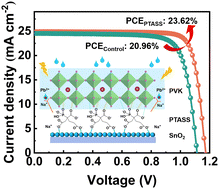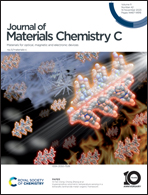Simultaneously enhancing the performance of perovskite solar cells and suppressing lead leakage via an interface modification strategy†
Abstract
The non-radiative recombination caused by perovskite and its relevant interfaces greatly impedes further improvement of the efficiency and stability of PSCs, hindering their further commercialization. Herein, we introduce a straightforward and effective approach to elevate the performance of SnO2-based planar PSCs by using 2-phosphonobutane-1,2,4-tricarboxylic acid sodium salt (PTASS) to modify the buried interface between SnO2 and the perovskite. The carrier extraction was greatly enhanced after the PTASS modification, owing to the better matching of energy levels at the interface between the SnO2 electron transport layer (ETL) and the perovskite material. The interfacial contact between SnO2 ETL and perovskite was also significantly improved. Consequently, the PTASS-optimized PSCs achieved a high efficiency of 23.62% with negligible hysteresis, and the stability of the corresponding device was also greatly elevated. In addition to interface modification and defect passivation, the PTASS modification was also beneficial for preventing lead ions leaking from damaged devices, which was crucial for promoting the commercialization progress of PSCs.

- This article is part of the themed collection: 2023 Journal of Materials Chemistry C HOT Papers


 Please wait while we load your content...
Please wait while we load your content...